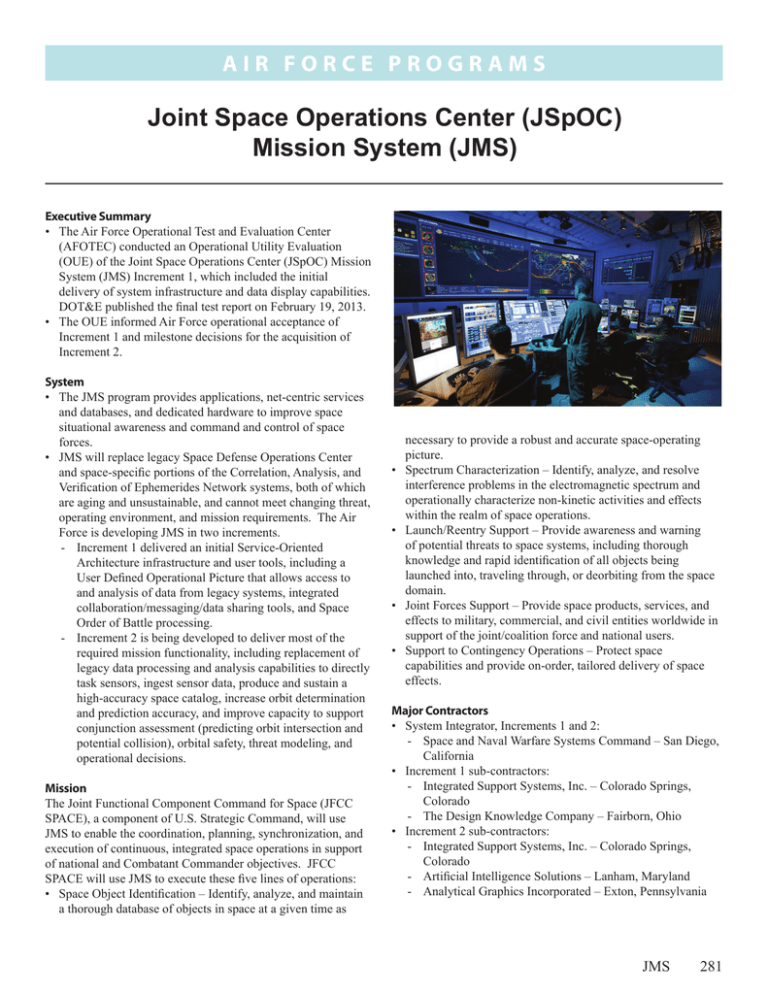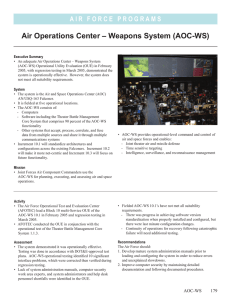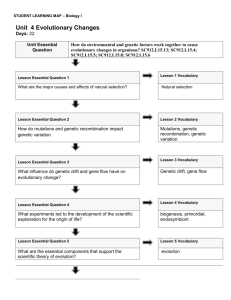Joint Space Operations Center (JSpOC) Mission System (JMS)
advertisement

A i r F o r c e P RO G R A M S Joint Space Operations Center (JSpOC) Mission System (JMS) Executive Summary • The Air Force Operational Test and Evaluation Center (AFOTEC) conducted an Operational Utility Evaluation (OUE) of the Joint Space Operations Center (JSpOC) Mission System (JMS) Increment 1, which included the initial delivery of system infrastructure and data display capabilities. DOT&E published the final test report on February 19, 2013. • The OUE informed Air Force operational acceptance of Increment 1 and milestone decisions for the acquisition of Increment 2. System • The JMS program provides applications, net-centric services and databases, and dedicated hardware to improve space situational awareness and command and control of space forces. • JMS will replace legacy Space Defense Operations Center and space‑specific portions of the Correlation, Analysis, and Verification of Ephemerides Network systems, both of which are aging and unsustainable, and cannot meet changing threat, operating environment, and mission requirements. The Air Force is developing JMS in two increments. - Increment 1 delivered an initial Service-Oriented Architecture infrastructure and user tools, including a User Defined Operational Picture that allows access to and analysis of data from legacy systems, integrated collaboration/messaging/data sharing tools, and Space Order of Battle processing. - Increment 2 is being developed to deliver most of the required mission functionality, including replacement of legacy data processing and analysis capabilities to directly task sensors, ingest sensor data, produce and sustain a high-accuracy space catalog, increase orbit determination and prediction accuracy, and improve capacity to support conjunction assessment (predicting orbit intersection and potential collision), orbital safety, threat modeling, and operational decisions. Mission The Joint Functional Component Command for Space (JFCC SPACE), a component of U.S. Strategic Command, will use JMS to enable the coordination, planning, synchronization, and execution of continuous, integrated space operations in support of national and Combatant Commander objectives. JFCC SPACE will use JMS to execute these five lines of operations: • Space Object Identification – Identify, analyze, and maintain a thorough database of objects in space at a given time as • • • • necessary to provide a robust and accurate space-operating picture. Spectrum Characterization – Identify, analyze, and resolve interference problems in the electromagnetic spectrum and operationally characterize non-kinetic activities and effects within the realm of space operations. Launch/Reentry Support – Provide awareness and warning of potential threats to space systems, including thorough knowledge and rapid identification of all objects being launched into, traveling through, or deorbiting from the space domain. Joint Forces Support – Provide space products, services, and effects to military, commercial, and civil entities worldwide in support of the joint/coalition force and national users. Support to Contingency Operations – Protect space capabilities and provide on-order, tailored delivery of space effects. Major Contractors • System Integrator, Increments 1 and 2: - Space and Naval Warfare Systems Command – San Diego, California • Increment 1 sub-contractors: - Integrated Support Systems, Inc. – Colorado Springs, Colorado - The Design Knowledge Company – Fairborn, Ohio • Increment 2 sub-contractors: - Integrated Support Systems, Inc. – Colorado Springs, Colorado - Artificial Intelligence Solutions – Lanham, Maryland - Analytical Graphics Incorporated – Exton, Pennsylvania JMS 281 A i r F o r c e P RO G R A M S Activity • AFOTEC, the JMS Program Office, and the 46th Test Squadron led an Integrated Test and Evaluation of JMS Increment 1 from August through October 2012. • AFOTEC conducted a dedicated OUE of JMS Increment 1 from November 2012 through January 2013. • DOT&E published a final OUE test report on February 19, 2013, which informed Air Force operational acceptance of Increment 1 and milestone decisions for the acquisition of Increment 2. • AFOTEC conducted all testing in accordance with the DOT&E-approved Test and Evaluation Master Plan and test plan. Assessment • AFOTEC’s OUE of JMS Increment 1 was adequate to assess JMS Increment 1 as effective and suitable for the limited capabilities delivered, including initial delivery of system infrastructure and data display functions. While useful relative to the existing legacy systems, Increment 1 delivered only a small subset of the full operational capabilities needed and expected with the full JMS, which are programmed and planned for delivery over the next several years. Increment 1 is not yet suitable for the JMS end-to-end mission, due to non-availability of some external data sources and infrastructure. • AFOTEC employed an integrated test methodology to optimize the use of data collection for future OT&E. Nothing was observed during the OUE that would preclude using Increment 1 as the basis for further JMS development. 282 JMS Recommendations • Status of Previous Recommendations. This is the first annual report for this program. • FY13 Recommendations. Consistent with the February 2013 DOT&E report on the JMS OUE, the Air Force should: 1. Develop an acquisition strategy for delivery of capabilities post-Increment 2, including facilities and capabilities to support continuity of operations. 2. Investigate and resolve problems with external data source consistency, external interfaces, and support networks that will otherwise impede JMS end-to-end mission performance. 3. Complete the planned technology refresh for Increment 1 equipment that currently limits system capacity and continue acquisition, development, testing, and fielding of JMS Increment 2. 4. Assess new Increment 2 capabilities and reassess JMS User Defined Operational Picture and net-centric capabilities to verify full JMS functionality. 5. Develop and validate model and simulation tools to support evaluation of system capacity under high-user loading and evaluation of JMS high-accuracy catalog size and accuracy. 6. Develop operationally-relevant measures to assess when JMS system performance degradation due to excessive loading or cyber-attack is no longer acceptable. Provide capabilities to allow system administrators to monitor performance and take appropriate actions to mitigate operational impacts based on these measures. 7. Conduct independent, non-cooperative, threat representative penetration testing to assess protect, detect, react, and restore components of cyber security for Increment 2.


